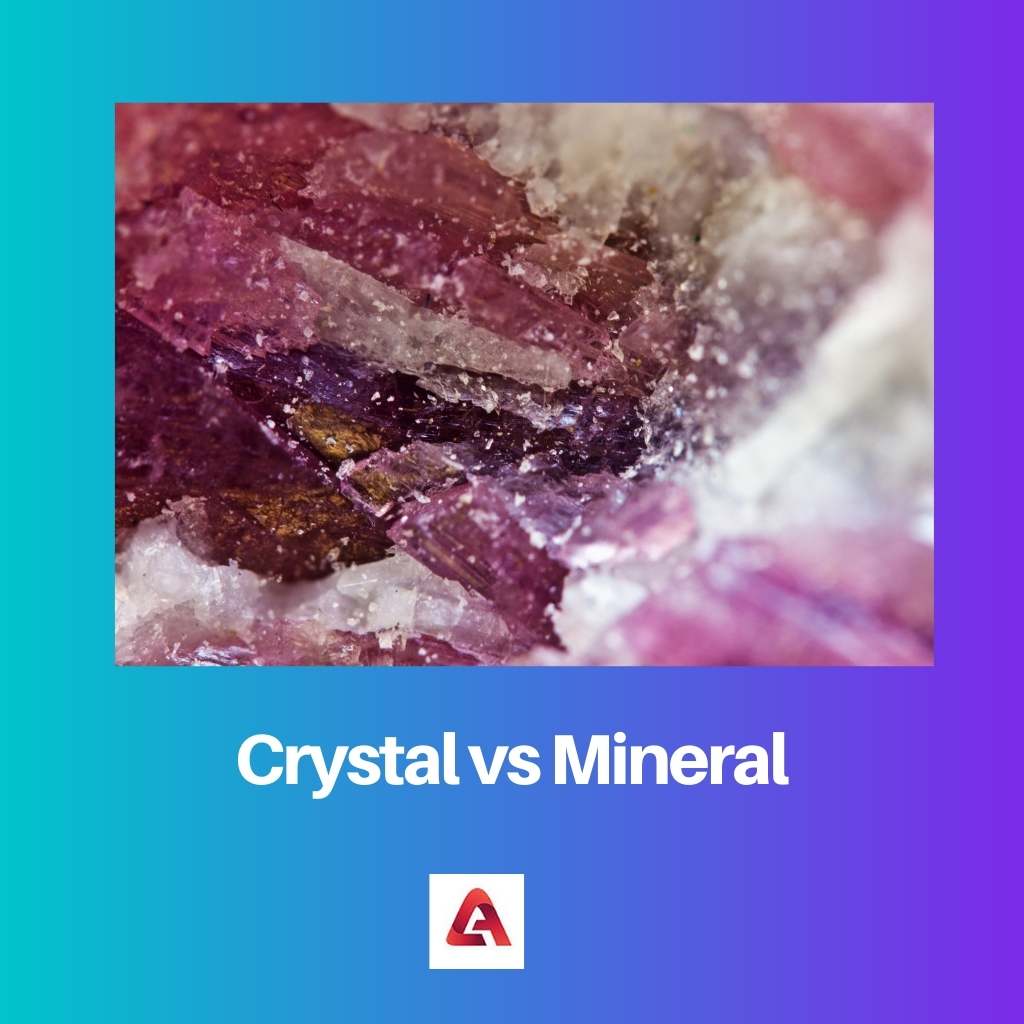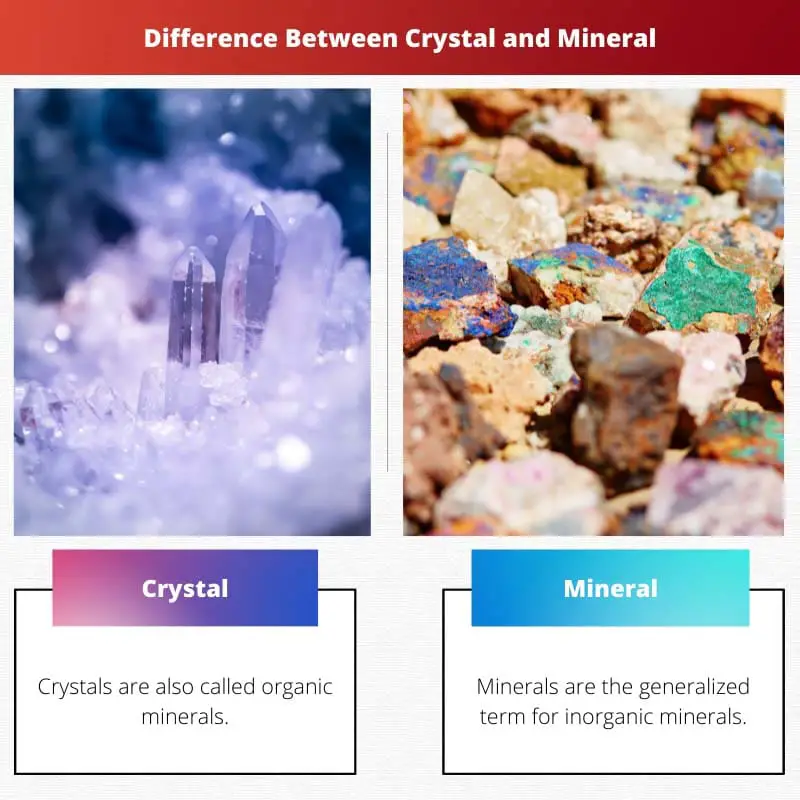Crystals and minerals can easily be confused as the component of crystals are minerals.
They only differ in their chemical structure, which gives them two very different chemical properties, making them dissimilar despite having similar atoms. To understand the difference, the structure has to be known.
Key Takeaways
- Crystals are solid materials with a regular, repeating pattern of atoms or molecules, while minerals are naturally occurring substances that are inorganic and have a crystalline structure.
- Crystals can be minerals, but not all minerals are crystals.
- Some examples of crystals include diamonds, quartz, and salt, while some minerals include gold, silver, and copper.
Crystal vs Mineral
The difference between crystals and mineral is that crystals and minerals are both made up of solid materials that have different chemical compositions and physical properties. Crystals are made up of elements are have regular and orderly arrangements, while the arrangement of elements in minerals is not orderly. These arrangements bring a difference to their chemical properties, making them different.

Crystal is a solid material whose molecules are arranged in a regularly ordered, repeating pattern. The order of molecules may create any structure of a crystal.
One common example of a crystal is salt, which is made up of sodium and chloride ions. The internal structure of the salt crystal can be described as a lattice.
The mineral is a natural substance that occurs in the earth. It is solid, but there are some exceptions.
They can be divided into two groups, namely common minerals and rare minerals. A mineral is a naturally occurring solid with specific chemical composition and a structure that does not change.
Most minerals have a crystalline structure that facilitates the specific composition. Its structure, however, cannot be described by a lattice.
Comparison Table
| Parameters of Comparison | Crystal | Mineral |
|---|---|---|
| Also Called | Crystals are also called organic minerals. | Minerals are the generalized term for inorganic minerals. |
| Structure | Crystal has repeated and organized chemical structures. | Minerals do not have an organization of chemical structure. |
| Lattice | The internal structure of a crystal can be described by a set lattice due to uniformity. | Minerals do not have a lattice structure. |
| Occurrence | Crystals may or may not be naturally occurring. | Minerals are naturally occurring. |
| Appearance | Crystal is transparent and reflective. | Minerals are coloured. |
What is Crystal?
Crystal is used as a noun. It refers to a clear, transparent kind of rock.
It also refers to rocks that are made up of many of these clear parts of the rock. It’s a mineral that is formed through pressure and heat deep within the Earth.
There are many kinds of crystals, but they all have the same basic materials.
The word crystal comes from the Greek word krystallos which means ice. The word has evolved, and there is a new definition.
Crystal now means a clear, transparent, solid substance made up of a specific arrangement of atoms, and it can be found in nature and man-made items.
Every kind of crystal has its unique arrangement of atoms, but they all have the same basic properties.
Crystals have a defined external shape, they have a particular internal structure, they have a fixed symmetry, and they have a specific way of growing. In most cases, they also have fixed internal surfaces.
The structure of the crystal can be determined by looking at the structure of the unit cell. The unit cell is the smallest repeating unit of the crystal structure that resembles the entire crystal structure.
In addition, with all crystals, their internal structure extends out to form a three–dimensional network with the help of hydrogen bonds, van der Waals forces, or, in the case of forces of attraction, covalent bonding.

What is Mineral?
A mineral is a naturally occurring material with an orderly atomic structure. Metals, non-metals, and gases are not minerals because they lack this ordered arrangement of atoms.
A mineral can be considered a pure substance that has no further decomposition into simpler substances.
In addition, it is naturally occurring, solid, inorganic, crystalline, and has an ordered atomic arrangement.
Most minerals have a specific crystal structure and are classified by their crystal systems, such as cubic or hexagonal.
Under general definitions, a mineral is an element or chemical compound that is naturally occurring, has a specific chemical composition and atomic arrangement and has particular physical properties.
The mineral is something that is found on the Earth. You can tell that it’s a mineral because it is either solid, perfect, shiny, white, grey, or black or in the shape of a rock.
There are millions of minerals on Earth, and most of them are not good to eat.
They are classified into different groups based on their chemical composition, such as oxides, halides, sulfides, and others.
Mining companies search for minerals in the Earth’s crust because of their valuable nature and use in a variety of applications, such as in electronics and manufacturing industries.

Main Differences Between Crystal and Mineral
- Crystals are made up of a homogenous chemical structure, and minerals are not homogenous mixtures.
- Crystals are made up of unique repeating patterns of atoms, and minerals do not have any such repeating patterns in their structure.
- Crystals can also be found in nature, meaning they are naturally occurring, but the forces of nature create minerals.
- Crystals are known as organic minerals, while minerals are known as inorganic minerals.
- Crystals have similar chemical properties throughout their structures, whereas minerals may differ in their chemical properties as their structure is irregular.

- https://pubs.rsc.org/en/content/articlehtml/2003/ce/b313552g
- https://books.google.com/books?hl=en&lr=&id=vdHGDwAAQBAJ&oi=fnd&pg=PR10&dq=minerals&ots=B5pbaTwekf&sig=fLLJFEAjaxek4kEsaScCUUlPo0U

The post has aptly detailed the comprehensive differences between crystals and minerals in a very informative manner. Impeccable work!
The differences between crystals and minerals may appear subtle, yet the chemical and structural variances explain their unique characteristics. Fascinating!
The comprehensive definitions and detailed comparison table make it easier to grasp the distinguishing features between crystals and minerals. Engrossing!
The detailed comparison table allows for easy differentiation between crystals and minerals, simplifying the understanding of the concepts. Highly insightful.
The comparison of crystals and minerals underscores the importance of understanding their distinctions. A very educative piece.
The post highlights how crystals and minerals can be distinguished through both their chemical composition and physical properties. An excellent resource for learners.
This post gave me a deeper insight into the complex world of crystals and minerals. I was not aware that crystals are organic whereas minerals are inorganic.
The light-hearted and humourous tone of the post made learning about the complex concepts of crystals and minerals engaging and entertaining.
Skillfully elucidating the differences between crystals and minerals with a light-hearted approach, the post is indeed impressive. Great work!
I appreciate the post’s engaging tone, making the otherwise complex subject engaging and enjoyable for readers.